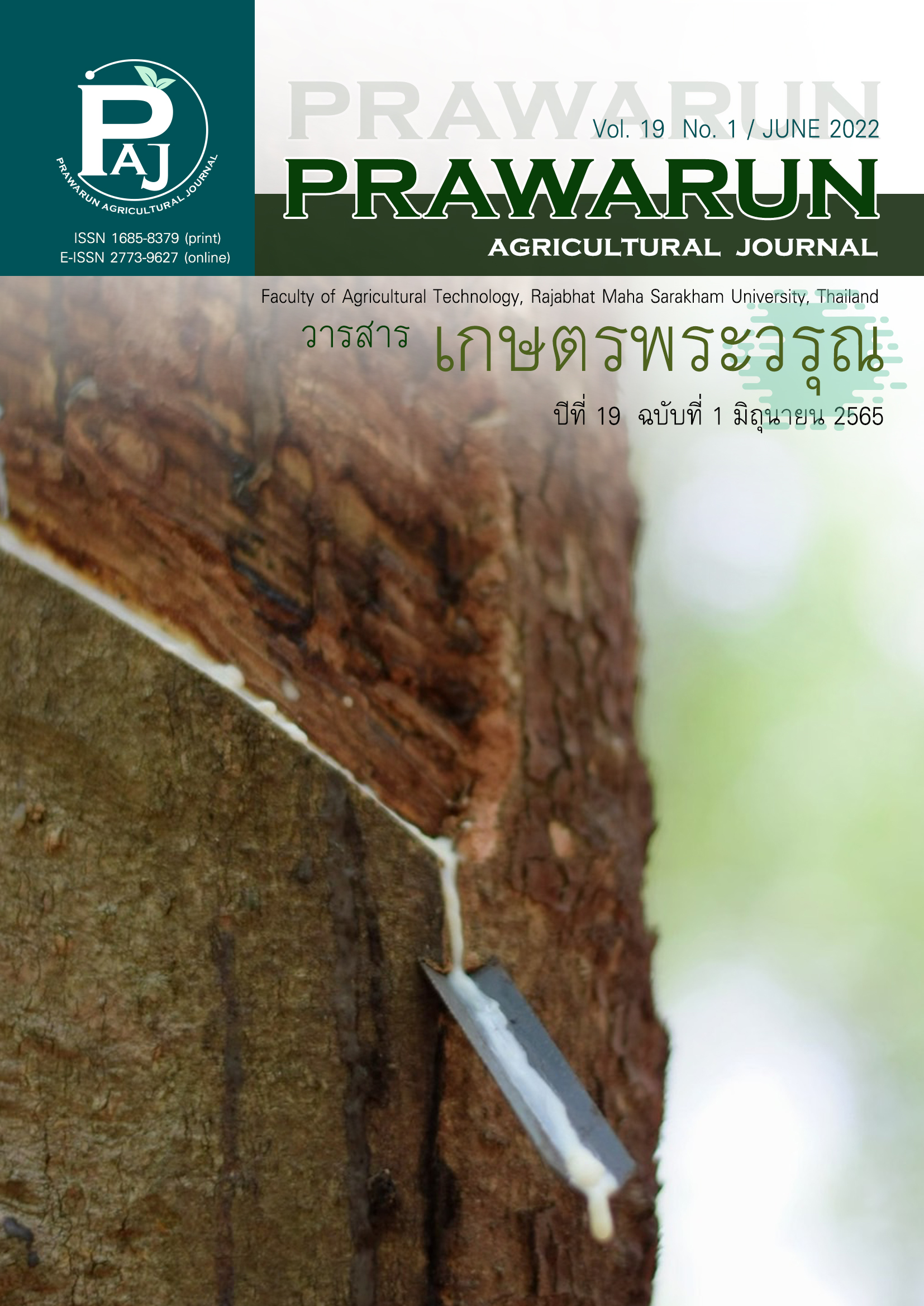ผลของระดับโปรตีนในอาหารข้นและแหล่งของอาหารหยาบ ต่อการกินได้ การย่อยได้ของโภชนะ และสมรรถภาพการเจริญเติบโตของแพะเนื้อลูกผสมพื้นเมือง
Main Article Content
บทคัดย่อ
การทดลองนี้มีวัตถุประสงค์ เพื่อศึกษาผลของระดับโปรตีนในอาหารข้นและแหล่งอาหารหยาบ ต่อปริมาณการกินได้ การย่อยได้โภชนะ กระบวนการหมักในกระเพาะหมัก ยูเรียในกระแสเลือด และสมรรถภาพการเจริญเติบโตของแพะเนื้อลูกผสมพื้นเมือง โดยใช้แพะเนื้อลูกผสมพื้นเมืองที่มีอายุระหว่าง 12 ถึง 15 เดือน จำนวน 16 ตัว เป็นเพศผู้ 8 ตัว และเพศเมีย 8 ตัว น้ำหนักตัวเริ่มต้นเฉลี่ย 18.74±1.8 กิโลกรัม ใช้แผนการทดลองแบบสุ่มสมบูรณ์ในบล็อก โดยจัดการทดลองแบบ 2x2 factorial in a Randomized Completely Block Design (RCBD) โดยมีปัจจัยที่ 1 คือ ระดับโปรตีนในอาหารข้น (12 และ 14 %) และปัจจัยที่ 2 คือ แหล่งของอาหารหยาบ (หญ้าเนเปียร์ปากช่อง 1 หมัก และหญ้าเนเปียร์ปากช่อง 1 หมักร่วมกับกระถิน (50:50)) มี 4 ซ้ำ ต่อทรีทเมนต์ แพะได้รับอาหารข้น 1.5 % ของน้ำหนักตัว และได้รับอาหารหยาบแบบเต็มที่ (ad libitum) เป็นระยะเวลาทดลอง 60 วัน ผลการทดลอง พบว่า ระดับโปรตีนในอาหารข้นและแหล่งของอาหารหยาบไม่มีอิทธิพลร่วมกัน ต่อปริมาณการกินได้ กระบวนการหมักย่อยในกระเพาะหมัก ระดับยูเรียในเลือด และสมรรถภาพการเจริญเติบโตของแพะเนื้อลูกผสมพื้นเมือง (P>0.05) แต่การใช้อาหารข้นระดับโปรตีน 14 % มีผลทำให้ระดับแอมโมเนียไนโตรเจนในกระเพาะหมัก (P=0.05) และระดับยูเรียในกระแสเลือดสูงขึ้น (P=0.006) และการใช้หญ้าเนเปียร์ปากช่อง 1 หมักร่วมกับกระถินเป็นแหล่งอาหารหยาบทำให้ปริมาณการกินได้ (P=0.0001) น้ำหนักตัวที่เพิ่ม (P=0.047) และอัตราการเจริญเติบโตต่อวันสูงขึ้น (P=0.046) ดังนั้นจากการศึกษาสามารถสรุปได้ว่าการใช้หญ้าเนเปียร์ปากช่อง 1 หมักร่วมกับกระถินเป็นแหล่งอาหารหยาบ (50:50) สามารถเพิ่มปริมาณการกินได้ และการเจริญเติบโตของแพะเนื้อลูกผสมพื้นเมือง ดังนั้นจึงสามารถใช้เป็นทางเลือกในการลดระดับโปรตีนในอาหารข้นได้เมื่อใช้หญ้าเนเปียร์ปากช่อง 1 หมักร่วมกับกระถินเป็นอาหารหยาบโดยไม่ส่งผลกระต่อสมรรถภาพการเจริญเติบโตของแพะเนื้อลูกผสมพื้นเมือง
Article Details
เอกสารอ้างอิง
Association of Official Analytical Chemists (AOAC). (1990). Official methods of analysis (14th ed.). Washington DC : Association of Official Analytical Chemists.
Barros–Rodrguez, M. A., Solorio–Sanchez, F. J., Sandoval–Castro, C. A., Klieve, Rojas–Herrera, R. A., Briceno–Poot, E. G., & Ku–Vera, J. C. (2015). Rumen function in vivo and in vitro in sheep fed Leucaena leucocephala. Tropical Animal Health and Production, 47(4), 757–764.
Bureenok, S., Sisaath, K., Homsai, W., Wongsuthavas, S., Yuangklang, C., & Vesupen, K. (2011). Fermentation quality and nutritive value of purple guinea grass and legumes silages. Khon Kaen Agriculture Journal, 39, 137–146. (in Thai)
Chanjula, P., Pakdeechanuan, P., Wasiksiri, S., & Tedprasit, S. (2014). Effects of dietary protein levels on digestibility, blood metabolites, and production performance of lactating dairy goats. Journal of Agriculture, 30(2), 191–200. (in Thai)
Crocker, C. L. (1967). Rapid determination of urea nitrogen in serum or plasma without deproteinization. American Journal of Medical Technology, 33(5), 361–365.
Ferguson, J. D., Galligan, D. T., Blanchard, T., & Reeves, M. (1993). Serum urea nitrogen and conception rate: the usefulness of test information. Journal of Dairy Science, 76(12), 3742–3746.
Hung, L. V., Wanapat, M., & Cherdthong, A. (2013). Effects of Leucaena leaf pellet on bacterial diversity and microbial protein synthesis in swamp buffalo fed on rice straw. Livestock Science. 151(2-3), 188–197.
Kaewkunya, C., Tayuan, C., Meenongyai, W., & Pronwapee, C. (2016). The use of lablab bean (Lablab purpureus L. Sweet) to improve forage sugarcane silage quality. Khon Kaen Agriculture Journal, 44(SUPPL. 1), 382–388. (in Thai)
Lloyd, S. (1982). Blood characteristics and the nutrition of ruminants. British Veterinary Journal, 138, 70–85.
Lounglawan, P., Lounglawan, W., & Suksombat, W. (2014). Effect of cutting and interval and cutting height on yield and chemical composition of King Napier grass (Pennisetum purpureum x Pennisetum americanum). APCBEE Procedia, 8, 27–31.
Marsetyo, Damry, Rusdi, Rusiyantono Y., & Syukur, S. H. (2017). The effect of supplementation of different legume leaves on feed Intake, digestion and growth of Kacang Goats given Mulato grass. Journal of Agricultural Science and Technology, 7, 117–122.
National Research Council (NRC). (1981). Nutrient requirements of goats: angora, dairy and meat goats in temperate and tropical countries. Washington D.C. : National Academy Press.
Sangthong, K., Noosen, P., & Ngampongsai, W. (2021). Effects of protein levels in concentrate on growth performance and nutrient utilization of growing indigenous male goat. Naresuan Phayao Journal, 14(1), 96–108. (in Thai)
Statistical Analysis System (SAS). (1996). SAS/STAT User’s Guide: Version 6.12 SAS Institute Inc (4th ed.). North Carolina: Cary.
Semae, S. (2016) Effects of Leucaena spp. to substitute roughage source in goats (research report). Naradhiwas: Faculty of Agriculture, Princess of Naradhiwas University. (in Thai)
Semae, S., & Kraiprom, T. (2018) Effects of leucaena (Leucaena leucocephala) as roughage source on goat performance and economic worthiness. Princess of Naradhiwas University Journal, 10(2), 140–149.
(in Thai)
Van Keulen, J., & Young, B. A. (1977). Evaluation of acid insoluble ash as a neutral marker in ruminant digestibility studies. Journal of Animal Science, 44(2), 282–287.
Van Soest, P. J., Robertson, J. B., & Lewis, B. A. (1991). Methods for dietary fiber, neutral detergent fiber and nonstarch polysaccharides in relation to animal nutrition. Journal Dairy Science, 74(10), 3583–3597.


